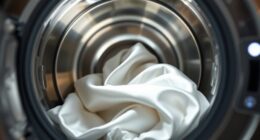Fleece fabric is your go-to for cozy blankets and stylish winter jackets. It's lightweight yet warm, made mainly from polyester, often recycled from plastic bottles. With types like polar fleece for insulation and microfleece for breathability, fleece suits various needs. It's popular in clothing and home decor, making it super versatile. Plus, caring for fleece is easy, ensuring it lasts. Stick around to discover more about choosing the right fleece and crafting ideas!
Key Takeaways
- Fleece fabric is a cozy, lightweight, and durable material, perfect for blankets and winter jackets alike.
- Types of fleece such as polar fleece and microfleece offer various warmth levels and moisture-wicking properties for different uses.
- Fleece is commonly used in clothing like jackets and hoodies, providing both style and insulation for colder weather.
- Proper care, including gentle washing and avoiding fabric softeners, helps maintain fleece's softness and durability over time.
- Eco-friendly options exist, as many fleece fabrics are made from recycled plastic bottles, promoting sustainability in fashion.
What Is Fleece Fabric?
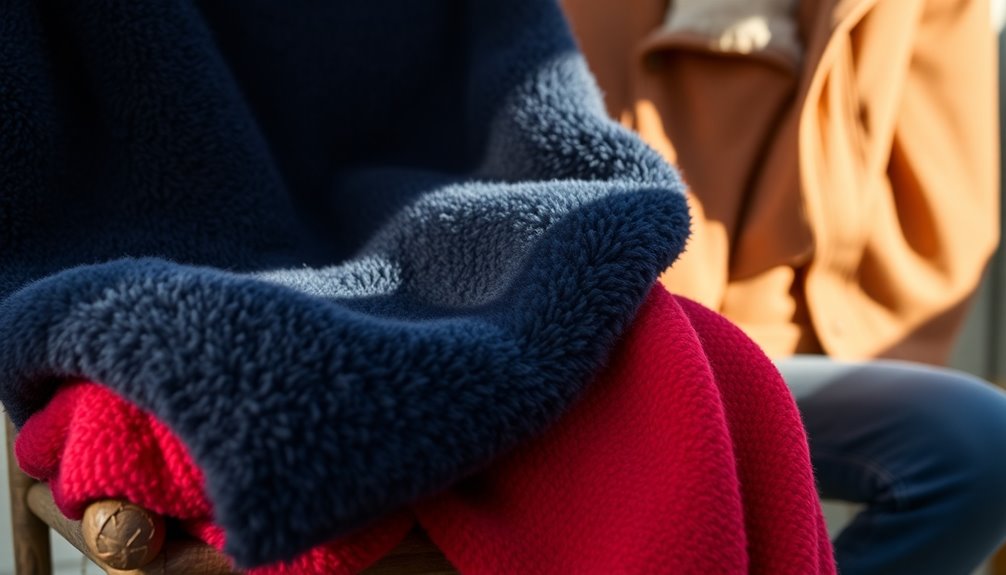
Fleece fabric is a cozy, synthetic material that's become a staple in many wardrobes. Made primarily from polyester fibers, it mimics the warmth of wool while being lighter and more durable.
You'll love the plush texture and comfort it offers, whether you're lounging at home or engaging in outdoor activities. Fleece is breathable and moisture-wicking, making it ideal for activewear and blankets alike.
You can find various fleece weights, from ultralight options perfect for summer to heavyweight choices designed for extreme cold conditions. Plus, many fleece fabrics come from recycled plastic bottles, promoting sustainability.
Being vegan and cruelty-free, fleece provides warmth without using animal-derived materials, making it a great choice for conscious consumers.
The Origin of Fleece Fabric
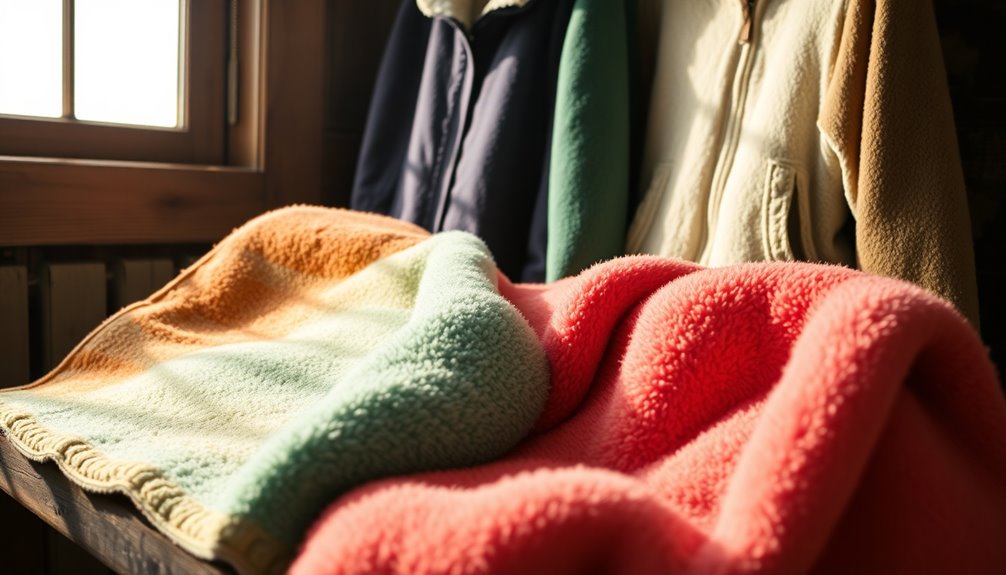
Developed in the late 1970s by Malden Mills in Massachusetts, fleece fabric aims to replicate the warmth and comfort of wool while offering a lightweight and durable alternative.
This innovative fabric was greatly influenced by Patagonia, which sought a functional solution for outdoor enthusiasts. By choosing not to patent the design, Malden Mills allowed for broader production and affordability, making fleece widely accessible.
Primarily crafted from synthetic fibers, fleece can even be made from recycled plastic bottles, emphasizing an eco-friendly approach to fabric manufacturing.
In 1981, Time Magazine recognized fleece as one of the greatest inventions of the 20th century, underscoring its revolutionary impact on winter clothing and outdoor gear.
What Is Fleece Fabric Made Of?
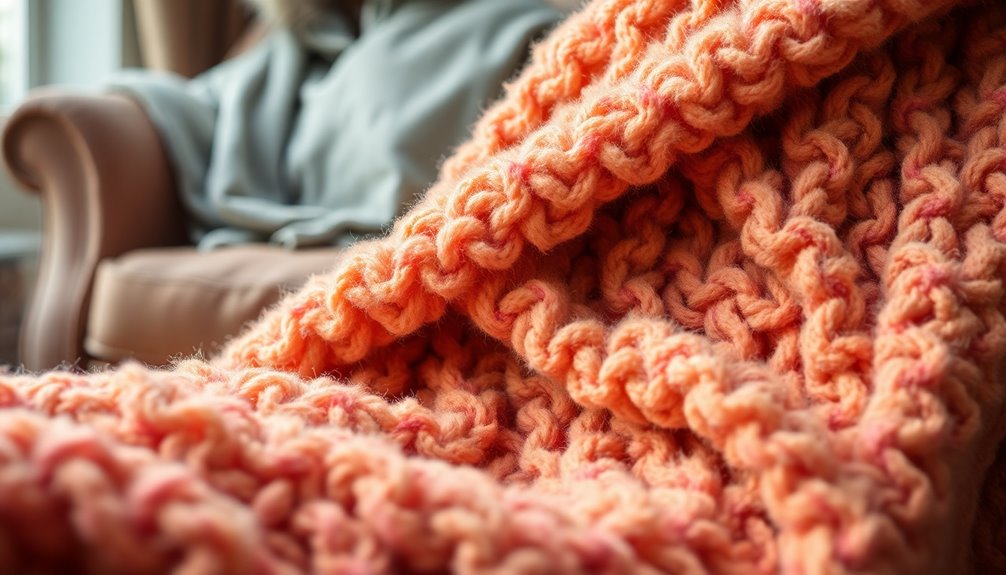
When it comes to fleece fabric, you'll find that it's primarily crafted from polyester, a synthetic material designed to provide warmth and comfort similar to natural wool.
Polyester fleece can even be made from recycled plastic bottles, promoting sustainability by reducing waste in fabric production. The soft, fluffy surface you love is created through a process of knitting or weaving polyester fibers, which are then brushed to enhance their texture.
While fleece isn't waterproof, it effectively wicks moisture away and boasts excellent insulating properties, trapping body heat while allowing breathability.
You can choose from different types of fleece, like microfleece or heavyweight fleece, depending on your needs for thickness and warmth, ranging from ultralight to very heavy.
Common Uses of Fleece Fabric
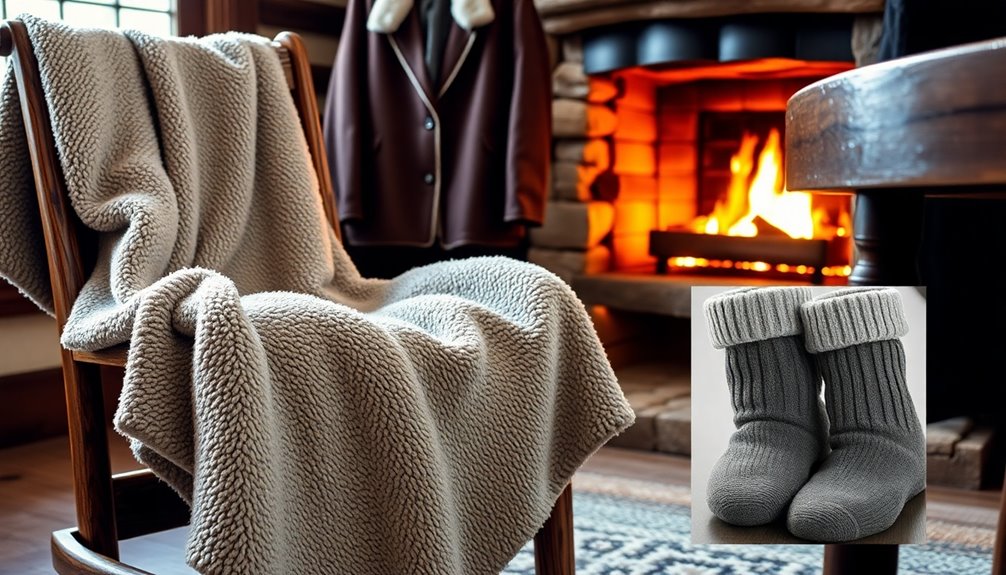
With its lightweight warmth and softness, fleece fabric finds a wide range of applications in everyday life.
You'll often see it used in clothing like fleece jackets and hoodies, providing both warmth and style during chilly days.
Microfleece is perfect for activewear, thanks to its breathability and moisture-wicking properties, making it ideal for outdoor activities.
At home, cozy fleece blankets and throws add comfort to your living space, available in various sizes, colors, and patterns.
Fleece is also a favorite for children's clothing and baby essentials, ensuring softness and durability.
Plus, it shines in home decor projects, such as pillowcases and pet beds, showcasing its versatility and ease of use in crafting.
Types of Fleece Fabric
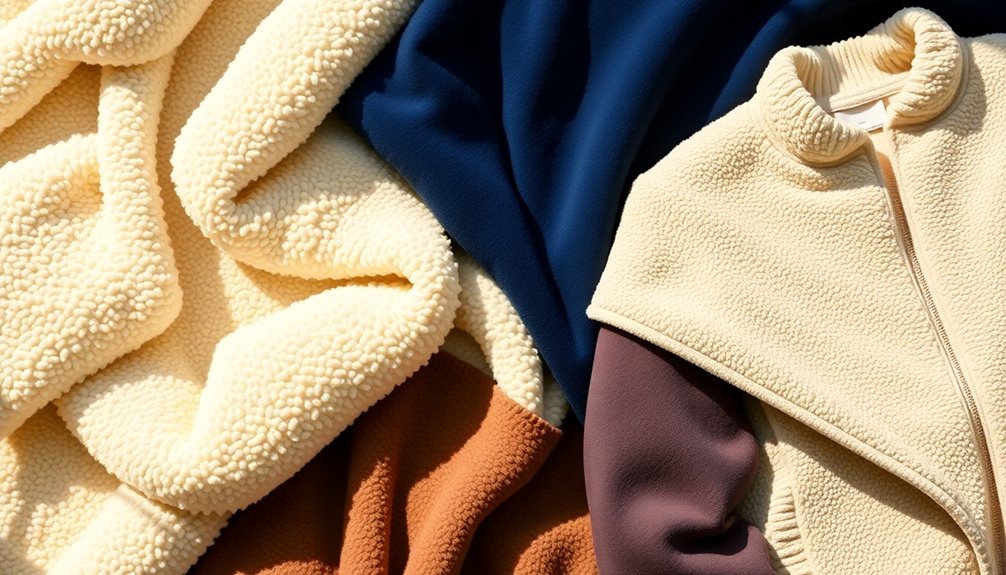
When it comes to fleece fabric, you've got some great options to explore.
Polar fleece keeps you warm during chilly days, while microfleece offers lightweight comfort for your active lifestyle.
Plus, don't forget about sherpa fleece, which adds a cozy touch to your home decor.
Polar Fleece Overview
Polar fleece stands out as a popular choice for cold-weather apparel and accessories, thanks to its incredible warmth and softness. This dense, insulating fabric is primarily made from polyester and weighs between 200-300gsm, making it both lightweight and perfect for layering. Its moisture-wicking properties enhance breathability, adding to its versatility in various outdoor and leisure activities. Plus, polar fleece is often produced from recycled plastic bottles, promoting sustainability without sacrificing performance. Here's a quick overview of polar fleece features:
| Feature | Description | Benefits |
|---|---|---|
| Warmth | Dense insulation | Keeps you warm |
| Lightweight | 200-300gsm | Easy to layer |
| Moisture-wicking | Helps manage sweat | Comfortable in all climates |
Microfleece Characteristics
Microfleece is the lightest variant of fleece fabric, typically weighing between 50-200 grams per square meter (gsm). This lightweight material features a soft, plush texture that offers warmth while remaining breathable, making it perfect for layering during outdoor activities.
Microfleece is also moisture-wicking, effectively drawing sweat away from your body, which helps keep you dry and comfortable when you're on the move. Its excellent combination of insulation and breathability makes it a popular choice for performance wear, such as base layers and lightweight jackets.
Plus, microfleece is durable and resistant to pilling, ensuring it maintains its appearance and functionality even after repeated washing. Whether you're hiking or lounging, microfleece has you covered.
Sherpa Fleece Benefits
While microfleece is a fantastic option for lightweight layering, sherpa fleece takes comfort and warmth to a whole new level.
This double-sided fabric mimics the texture of wool, providing exceptional insulation for your winter clothing and cozy blankets. Its lightweight nature makes it effective at retaining heat, so you can stay snug during chilly days.
Plus, sherpa fleece is moisture-resistant, giving you added protection against dampness while remaining breathable.
You'll love how easy it's to care for, as it's machine washable on gentle cycles, ensuring long-lasting softness and durability.
Whether you're lounging at home or braving the elements, sherpa fleece enhances your comfort like no other fabric can.
Features and Benefits of Fleece
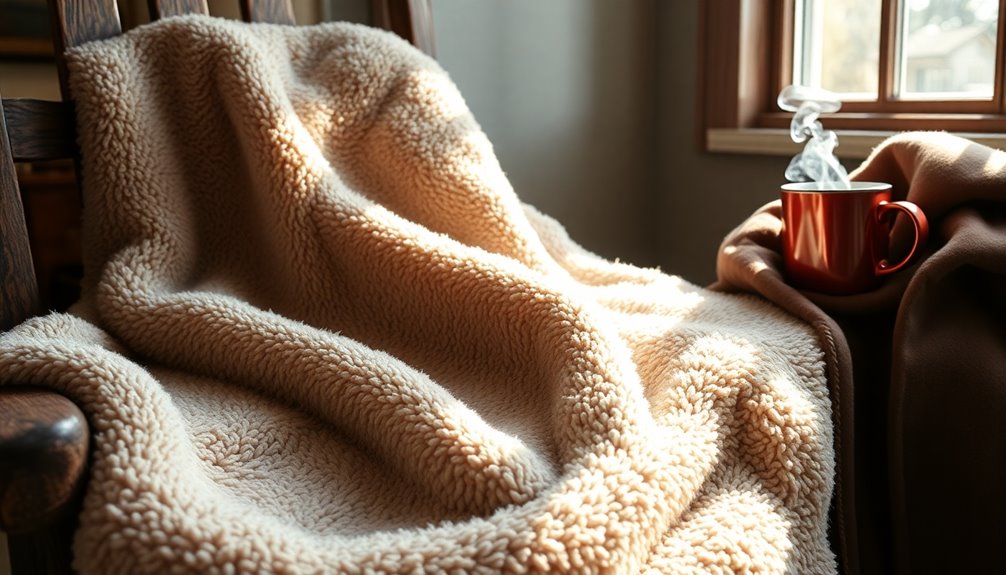
Fleece offers a unique combination of softness and warmth, making it a top choice for anyone looking to stay cozy in cold weather. Here are some key features and benefits:
- Warmth without Bulk: Fleece is warm yet lightweight, allowing for easy layering in cold conditions.
- Highly Breathable: This fabric promotes air circulation, preventing overheating while still trapping heat for comfort and warmth.
- Durability and Sustainability: Often made from recycled plastic bottles, fleece isn't only durable but also eco-friendly.
Thanks to its moisture-wicking properties, fleece draws sweat away from your body, keeping you dry during outdoor activities.
When you choose fleece, you're opting for a functional fabric that meets your needs in chilly weather.
Choosing the Right Fleece for Your Needs
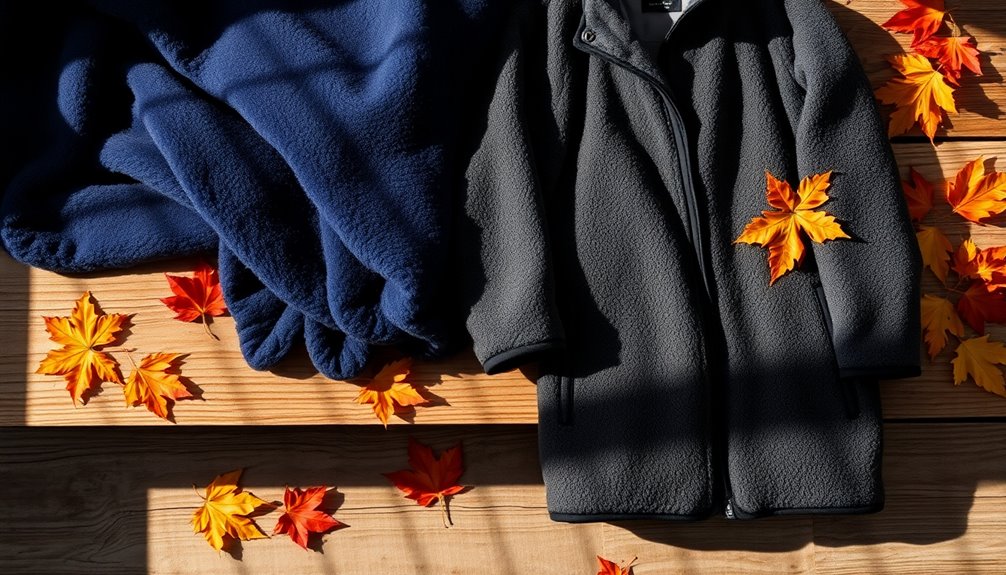
How do you choose the right fleece for your needs? Start by considering the weight of the fleece.
Light fleece, ranging from 100-200gsm, is perfect for mild conditions, while heavyweight fleece (300gsm+) is ideal for extreme cold.
If you're active, look for moisture-wicking properties to keep sweat at bay and enhance breathability of the fleece, preventing overheating.
For layering, microfleece works best, while polar fleece provides warmth for jackets and blankets.
Be mindful of additional features like wind resistance and water-repellency treatments, as they can improve performance in harsh weather.
Finally, watch out for high amounts of static that can occur with certain fleece types, as this can affect your comfort during wear.
Caring for Fleece Fabrics
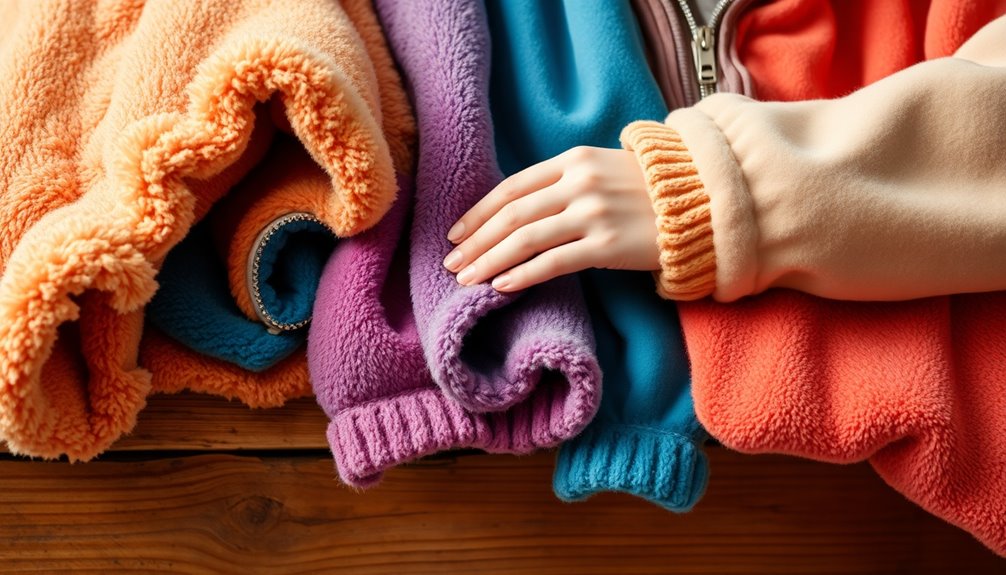
Caring for your fleece fabrics is essential to keep them looking and feeling great.
You'll want to wash them in cold water and dry them properly to avoid damage.
Plus, storing fleece the right way can help prevent pilling and maintain its plush quality.
Washing and Drying Tips
To keep your fleece looking and feeling great, washing it properly is essential. Follow these tips for ideal care:
- Wash in cold water on a gentle cycle to maintain softness and durability. Avoid bleach and fabric softeners, as they can compromise fleece's moisture-wicking properties.
- Remove pet hair using a lint roller before washing, ensuring your fleece stays clean and presentable.
- Tumble dry on low heat or hang to dry. High temperatures can damage fibers and lead to shrinkage.
Always check the care labels for specific washing instructions, as different fleece types may have unique maintenance requirements.
With these tips, your fleece will stay cozy and last longer.
Preventing Pilling Issues
While keeping your fleece clean is important, preventing pilling is equally essential for maintaining its appearance and comfort. Pilling occurs when loose fibers tangle, often due to friction during wear or washing. To keep your fleece looking great, follow these tips:
| Step | Action | Notes |
|---|---|---|
| 1. Washing | Always wash in cold water | Use a gentle cycle |
| 2. Fabric Softeners | Avoid using bleach or fabric softeners | They can damage the fibers |
| 3. Inside Out | Turn fleece items inside out before wash | Minimizes abrasion |
| 4. Maintenance | Use a lint roller or fabric shaver | Removes existing pills |
Storing Fleece Properly
Properly storing your fleece is essential for keeping it in top condition. To maintain integrity and guarantee longevity, follow these tips:
- Use breathable storage: Opt for breathable bags or bins to protect fleece from dust and moisture while allowing air circulation.
- Avoid tight folding: Roll or store fleece loosely to prevent creasing and maintain that fluffy texture you love.
- Separate from snagging items: Keep fleece away from zippers or hooks to protect its surface quality.
Additionally, regularly check your stored fleece for pests or damage.
Ascertain items are clean and debris-free before packing them away for long-term storage.
Crafting Projects With Fleece
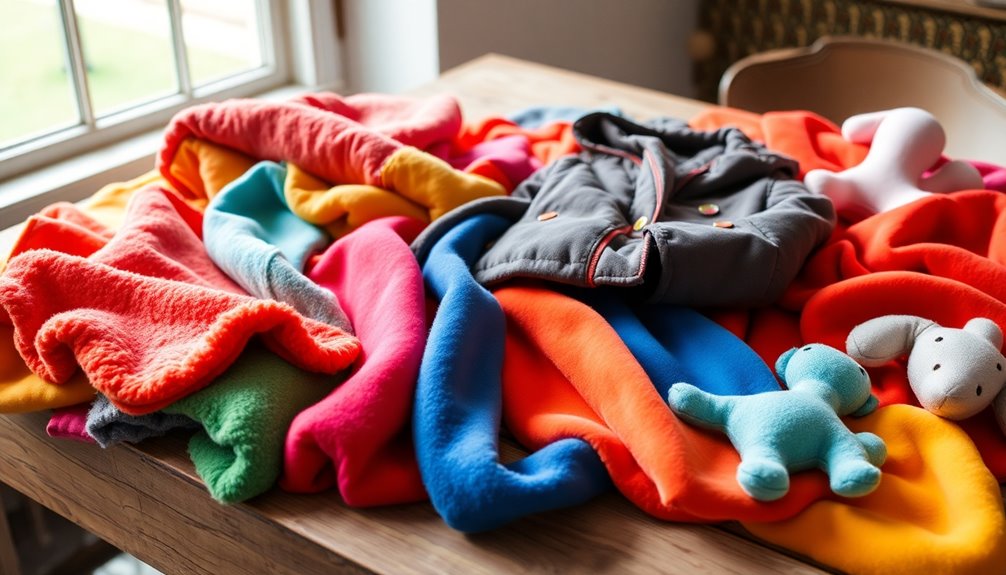
Crafting projects with fleece opens up a world of creative possibilities, thanks to its softness and durability. You can make cozy blankets, stylish clothing, and functional accessories. When sewing, use a ballpoint needle and a longer stitch to prevent fabric bunching. Heavyweight fleece (300gsm+) is perfect for warm winter garments, while microfleece (up to 200gsm) suits lightweight applications. Fleece is moisture-resistant and quick-drying, ideal for outdoor projects. Remember, excessive pinning can damage the fabric's texture, so opt for hand-sewn embellishments instead.
| Project Type | Fleece Weight |
|---|---|
| Lightweight Items | Microfleece (up to 200gsm) |
| Warm Winter Garments | Heavyweight (300gsm+) |
| Blankets | Medium to Heavy |
| Accessories | Any Weight |
Eco-Friendly Aspects of Fleece

Fleece isn't just a versatile fabric for crafting; it also offers significant eco-friendly benefits. By choosing fleece, you're not only enjoying warmth and comfort but also supporting sustainability.
Here are three key eco-friendly aspects of fleece fabrics:
- Recycled Materials: Many fleece fabrics are made from recycled plastic bottles, reducing waste in landfills.
- Lower Carbon Footprint: Producing fleece from recycled materials decreases reliance on virgin polyester, cutting down emissions compared to traditional synthetic materials.
- Durability: Fleece's durability means it lasts for years, minimizing the need for replacements and further textile waste. Additionally, the high fiber content of fleece can contribute to its long-lasting nature, ensuring that it remains functional for a longer period.
Frequently Asked Questions
What Is the Warmest Fleece You Can Buy?
When you're looking for the warmest fleece, heavyweight options between 300gsm and 500gsm are your best bet.
Styles like Polartec and high loft fleece give you maximum insulation while still allowing breathability.
Sherpa fleece, with its thick texture, provides incredible warmth, making it perfect for jackets or blankets.
Don't forget about wind-resistant and water-repellent treatments, which boost your fleece's effectiveness against cold weather, ensuring you stay cozy even in harsh conditions.
What Is the Difference Between Fleece and Blizzard Fleece?
When you compare fleece and Blizzard fleece, you'll notice key differences in warmth and texture.
Standard fleece is lightweight and breathable, making it great for layering.
In contrast, Blizzard fleece is heavier, often over 300gsm, with a thicker, plush surface that traps heat better.
It's more durable and resistant to pilling, making it ideal for cold conditions and high-wear situations like jackets or outdoor gear.
Choose based on your warmth needs!
What Is the Warmest Fleece Fabric?
If you're looking for the warmest fleece fabric, you won't believe how cozy heavyweight fleece can be!
Typically weighing 300gsm or more, it's perfect for extreme cold.
High loft fleece offers incredible insulation while staying lightweight, and Polartec fleece stands out with its advanced technology for warmth without bulk.
Don't forget to take into account merino fleece for its moisture-wicking properties, plus look for wind-resistant features to keep you toasty in harsh conditions.
What Is the Difference Between Polartec Fleece and Regular Fleece?
Polartec fleece and regular fleece differ mainly in performance and construction.
When you choose Polartec, you get superior breathability and moisture-wicking properties, making it ideal for active outdoor activities.
Regular fleece, while warm, can trap heat and lacks the same level of durability and water resistance.
Polartec's unique knit structure promotes better air circulation, helping you regulate body temperature effectively, while regular fleece typically offers less versatility in weight and function.
Conclusion
Now that you know all about fleece, don't let the misconception that it's only for winter hold you back. Imagine curling up in a lightweight fleece throw on a cool summer evening, or sporting a stylish fleece vest during a spring hike. Fleece isn't just warm; it's versatile and perfect for year-round comfort. Whether you're crafting or cozying up, fleece has got you covered. Embrace its softness and make it a staple in your life!









